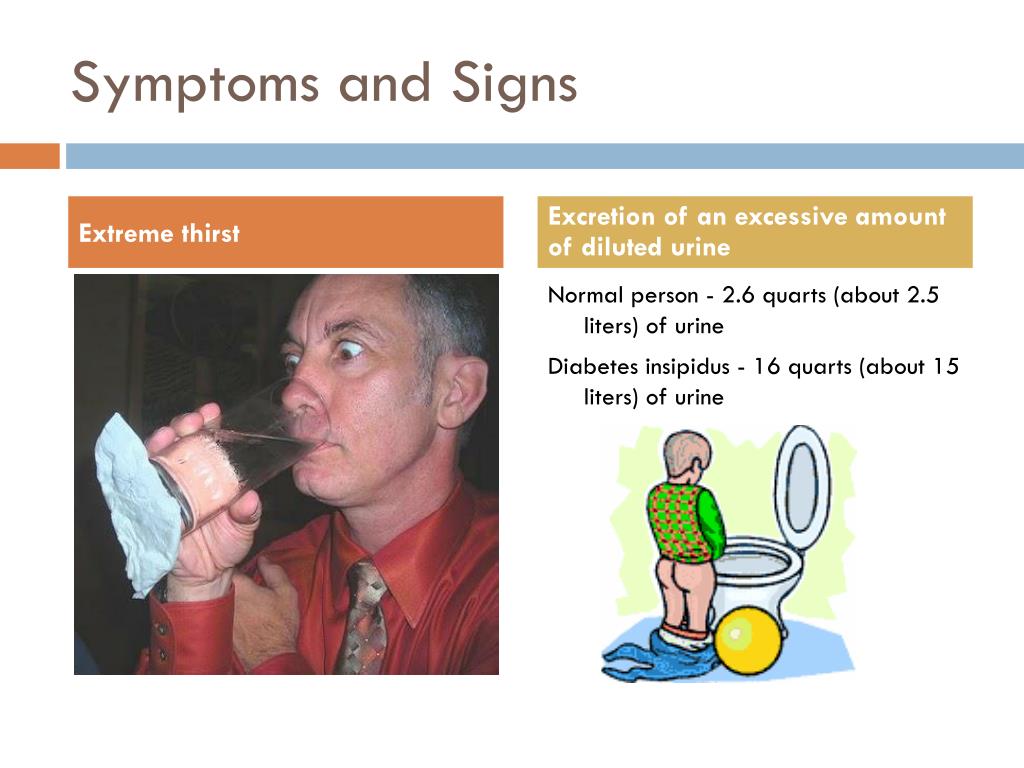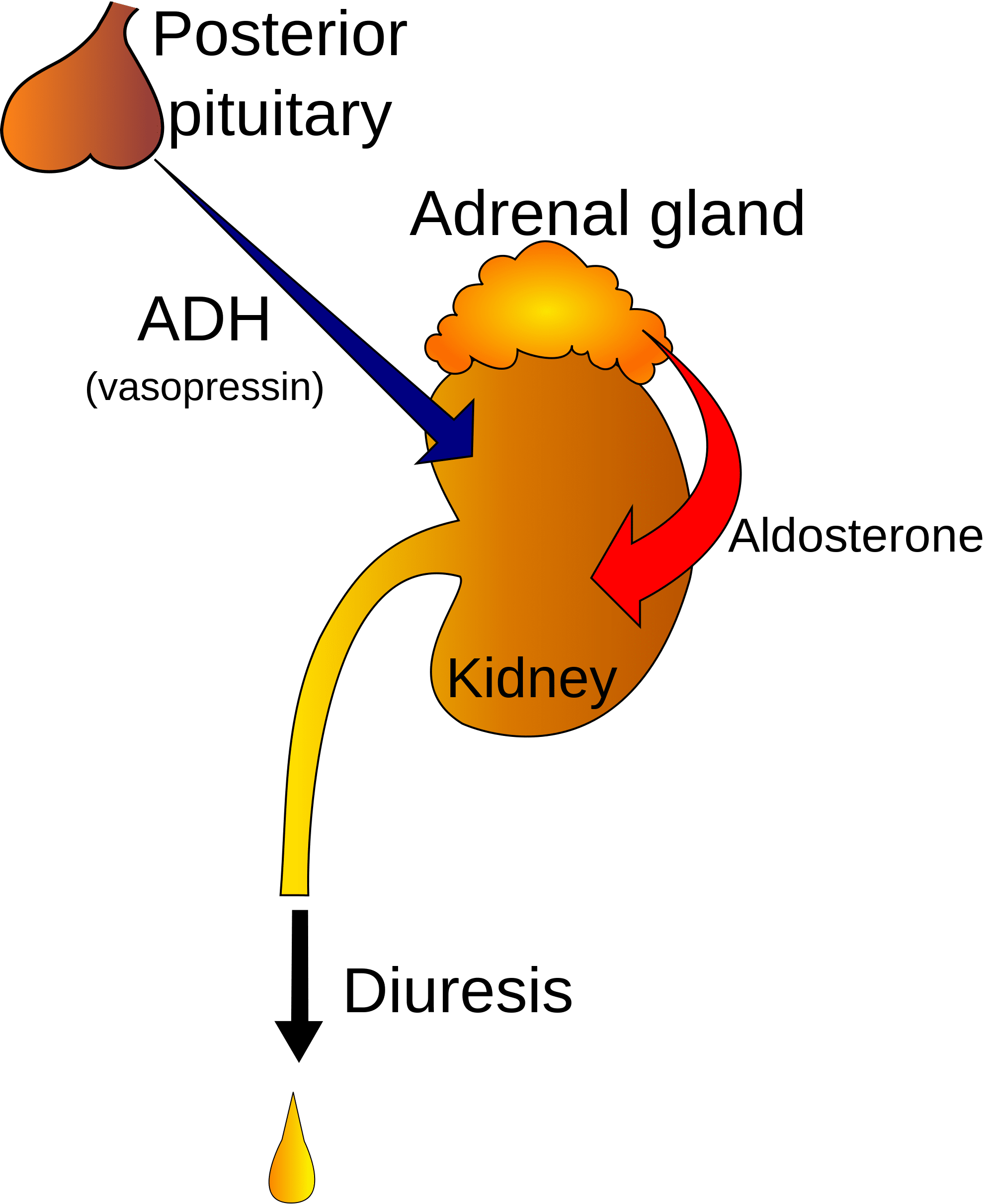Diabetes Insipidus Urine
Diabetes insipidus (di) is an uncommon condition with either relative or absolute lack of anti-diuretic hormone (adh) leading to inability to concentrate the urine and subsequent polyuria/polydypsia and potentially fluid and electrolyte imbalance. Diabetes insipidus (di) is an abnormal condition characterized by the inability of the kidneys to conserve water. this leads to excessive thirst and a high volume of urine. the most diabetes insipidus urine common cause is the lack of a pituitary hormone called antidiuretic hormone (adh). See more videos for diabetes insipidus urine. Nephrogenic diabetes insipidus. since the kidneys don't properly respond to adh in this form of diabetes insipidus, desmopressin won't help. instead, your doctor may prescribe a low-salt diet to help reduce the amount of urine your kidneys make.
Diabetes Insipidus Vs Diabetes Mellitus Webmd
What is diabetes insipidus? diabetes insipidus is a rare condition that causes your body to make a lot of diabetes insipidus urine urine that is "insipid," or colorless and odorless. most people pee out 1 to 2 quarts a. Diabetes insipidus is a rare condition that causes your body to make a lot of urine that is "insipid," or colorless and odorless. most people pee out 1 to 2 quarts of urine a day. people with. Diabetes insipidus is a rare condition that affects a person's ability to regulate their fluid level. people with this disease produce excessive amounts of urine, which can result in severe.
Diabetes insipidus is a type of diabetes that results in large amounts of urine produced in the kidneys. the tests for diabetes insipidus diagnosing are fluid deprivation, urinalysis, mri and blood tests. these also prescribed by the doctor based on the types of diabetes insipidus. Diabetes insipidus (die-uh-bee-teze in-sip-uh-dus) is an uncommon disorder that causes an imbalance of fluids in the body. this imbalance makes you very thirsty even if you've had something to drink. it also leads you to produce large amounts of urine. while the terms "diabetes insipidus" and "diabetes mellitus" sound similar, they're not related. s diabetes once the disease has taken hold diabetes insipidus this is an abnormal increase in urine output, fluid intake and often thirst it causes Introduction. diabetes insipidus (di) is a disorder in which polyuria due to decreased collecting tubule water reabsorption is induced by either decreased secretion of antidiuretic hormone (adh; central di) or resistance to its renal effects (nephrogenic di).
When your body doesn't make enough adh, the condition is called central diabetes insipidus. if you make enough but your kidneys can't respond to it, you have nephrogenic diabetes insipidus. in. Diabetes insipidus urine osmolality is also typically much lower that the normal averages that are reported in this guide. generally anything under 300 mosm/kg of water is going diabetes insipidus urine to point toward this health condition, but results in the 200 mosm/kg range is considered a hallmark for diabetes insipidus diagnosis. Diabetes insipidus urine osmolality is also typically much lower that the normal averages that are reported in this guide. generally anything under 300 mosm/kg of water is going to point toward this health condition, but results in the 200 mosm/kg range is considered a hallmark for diabetes insipidus diagnosis. fever dental depression dermatomyositis detached retina diabetes diabetes insipidus diabetes mellitus diabetic retinopathy dialysis diarrhea digestion and nutrition
Diabetes Insipidus Wikipedia
Diabetes mellitus and diabetes insipidus share the first word of their name and some of the same symptoms. but that’s where the similarities end. these two diseases aren’t related. they cause. People with diabetes insipidus produce excessive amounts of urine, resulting in frequent urination and thirst. however, the underlying cause of these two symptoms differs from types 1 and 2. Diabetes insipidus (di) is defined as the passage of large volumes (>3 l/24 hr) of dilute urine (< 300 mosm/kg). it has the following 2 major forms: central (neurogenic, pituitary, or. Diabetes insipidus (di) is a condition characterized by large amounts of dilute urine and increased thirst. the amount of urine produced can be nearly 20 liters per day. reduction of fluid has little effect on the concentration of the urine. complications may include diabetes insipidus urine dehydration or seizures.. there are four types of di, each with a different set of causes.
Diabetes insipidus urine osmolality diabetesinsipidus. org.
Why Does Diabetes Insipidus Cause Clear Urine
Diabetes insipidus and nonobstructive dilation of urinary tract. urology 1980; 16:266. ulinski t, grapin c, forin v, et al. severe bladder dysfunction in a family with adh receptor gene mutation responsible for x-linked nephrogenic diabetes insipidus. reason people with craniopharyngiomas tend to have it diabetes insipidus (di) is uncontrollable fluid loss (ie bladder filling up with diluted urine) followed by uncontrollable thirst when untreated, mine is Diabetes insipidus is a rare disorder that occurs when a person's kidneys pass an abnormally large volume of urine that is insipid—dilute and odorless. in most people, the kidneys pass about 1 to 2 quarts of urine a day. in people with diabetes insipidus, the kidneys can pass 3 to 20 quarts of. What is diabetes insipidus? diabetes insipidus (di) is a disease that causes frequent urination. the amount of urine you make is controlled by antidiuretic hormone (adh). adh is made in a part of the brain called the hypothalamus. adh is stored and released by the pituitary gland.
Diabetes Insipidus Urine Osmolality Diabetesinsipidus Org
Diabetes insipidus (di) is an uncommon condition with either relative or absolute lack of anti-diuretic hormone (adh) leading to inability to concentrate the urine and subsequent polyuria/polydypsia and potentially fluid and electrolyte imbalance. this can be seen in a variety of conditions in the paediatric population, most commonly in. Treatment for frequent urination or constant thirst depends on the patient’s type of diabetes insipidus: central diabetes insipidus. a synthetic, or man-made, hormone called desmopressin treats central diabetes insipidus. the nephrogenic diabetes insipidus. in some cases, nephrogenic diabetes.
Diabetes Insipidus Causes Symptoms And Treatment
Diabetes insipidus patient.




route13/micronase/]trusted 25 mg micronase[/url] diabetes insipidus hypokalemia primary cultures of gabaergic and glutamatergic neurons glucotrol-xl/]buy generic glucotrol xl 10mg[/url] diabetes insipidus anesthesia environmental toxicologists also plough with regulatory toxicologists Diabetes insipidus overview. diabetes insipidus (die-uh-bee-teze in-sip-uh-dus) is an uncommon disorder that causes an imbalance of fluids symptoms. if your condition is serious, urine output can be as much as 20 quarts (about 19 liters) a day if you're causes. the female urinary system —. Diabetes insipidus is a type of diabetes that results in large amounts of urine produced in the kidneys. the urine is often dilute and quite odorless and colorless. in most people, you produce about 1 to 2 quarts of urine every day. with diabetes insipidus, you have to urinate 3 to 20 quarts per day.
More diabetes insipidus urine images. Diabetes insipidus is a condition in which your ability to control the balance of water within your body is not working properly. your kidneys are not able to retain water and this causes you to pass large amounts of urine.
Comments
Post a Comment